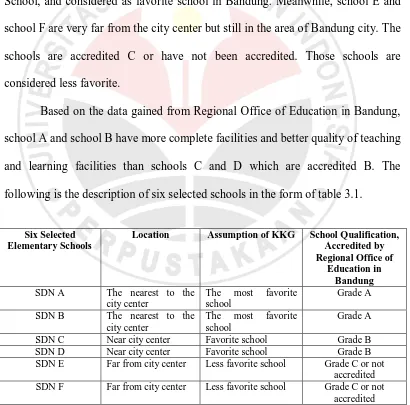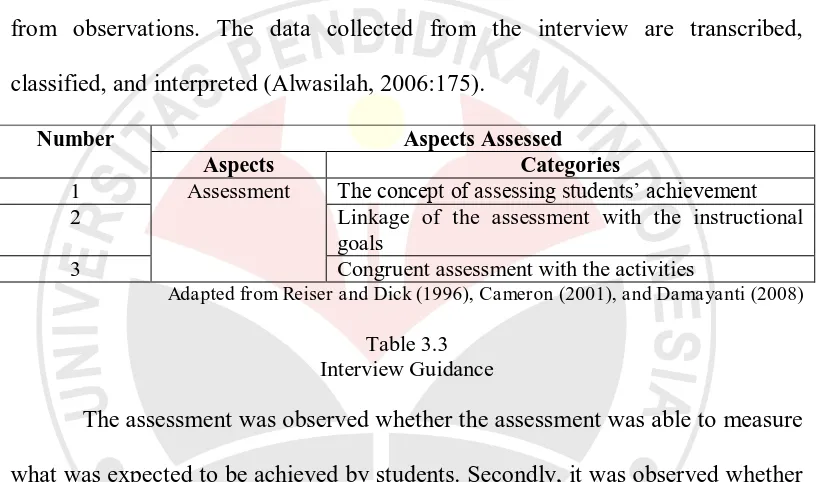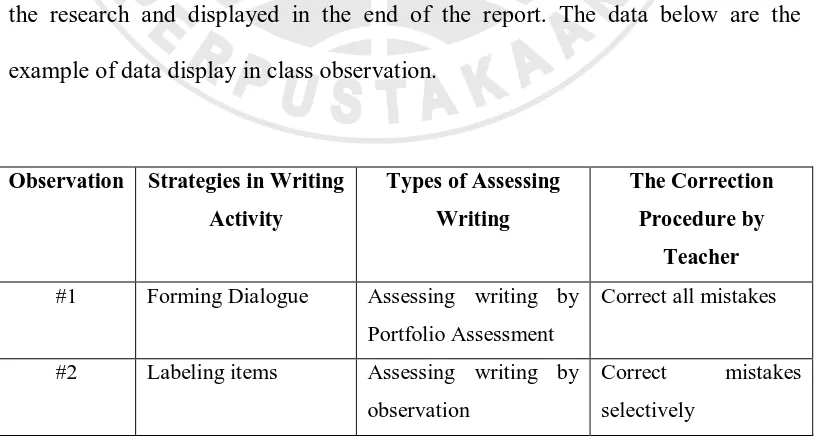CHAPTER III
RESEARCH METHODOLOGY
This chapter discusses the research methodology used in the study. It
covers statement of the problem, methodology of the study, definition of key
terms, site and participants, data collection methods, data analysis, and concluding
mark.
3.1Statements of the Problem
This study was conducted to answer the following questions:
a. What kinds of strategies are applied by the English teachers in assessing
writing in EYL context at Primary School in Bandung?
b. Why do teachers choose those assessment strategies?
c. To what extent is the assessment appropriate for the teaching programs?
3.2 Methodology of the Study
In this study, descriptive method was used. Through qualitative research
design, Silverman (2005:15) states “the researcher can get complex and also holistic picture about the problem” and it is evident in the comments of Sugiyono
(2006) and Sukmadinata (2007) when they state that the purpose of conducting
the descriptive method is to give a portrait in real condition without interference
information of the assessment strategies used by English teachers at primary schools, the teachers’ reasons in choosing those strategies, and the appropriate
assessment for the young learners.
In qualitative research, as explained by Sugiyono (2007:8), the design allows the researcher to examine students’ written texts that were produced in
natural classroom activities. The idea is same with Alwasilah (2006:78) and
Fraenkel and Wallen (1993:11) when they state that, in the natural classroom, the researcher can use the result of students’ written as data. The descriptive method
is also used for solving the found problems in the research (Arikunto, 2006; and
Sukamandinata, 2007). In order to keep the naturalness, the researcher avoids any
act of manipulations or interventions to the classroom activities by focusing on
assessment.
As discussed by Nunan (2000:79), this method also allows the researcher
to investigate a phenomenon in single case or in a single instance of a class.
Moreover, by using case study, Cresswell (1994:61) also acknowledges that the
exploration can be conducted over time through detailed in collecting many
sources of information. Therefore, this study used class observation, interviewing,
and document analysis (Alwasilah, 2006:142).
3.3 Site and Participants
3.3.1 The Site
The study was conducted in six public elementary schools in Bandung.
cited in Setiyadi (2006) that subject for case study is selected on purpose. The
schools chosen were school A, school B, school C, school D, school E, and school
F. School A and school B are the nearest to city center in Bandung, A grade
accredited school, and considered as the most favorite school in Bandung.
Different from school A and school B, school C and school D are around city
center of Bandung. It is not far from the city center. Those are B grade accredited
School, and considered as favorite school in Bandung. Meanwhile, school E and
school F are very far from the city center but still in the area of Bandung city. The
schools are accredited C or have not been accredited. Those schools are
considered less favorite.
Based on the data gained from Regional Office of Education in Bandung,
school A and school B have more complete facilities and better quality of teaching
and learning facilities than schools C and D which are accredited B. The
following is the description of six selected schools in the form of table 3.1.
Six Selected Elementary Schools
Location Assumption of KKG School Qualification, Accredited by Taken from Regional Office of Education of Bandung Center and KKG (2012)
Table 3.1
3.3.2 The Participants
There was one participant for each school. So there were six participants
who took part in this study coded as Teacher 1 (T1), Teacher 2 (T2), Teacher 3
(T3), Teacher 4 (T4), Teacher 5 (T5), and Teacher 6 (T6).
Respondents Schools Grades Assessments
Symbol
The differences of the educational background of the teachers, facilities,
and other factors would influence the way teachers teach English to the students.
It would be necessary for the researcher to get more information in this study.
3.4 Data Collection Methods
In collecting the data of qualitative research, as described by Alwasilah
collecting the data is a strategy that combines more than one method of collecting
data for the research. Using only a single method in gaining the data cannot
provide enough data and description of the phenomena happen in doing
qualitative research. Using triangulation in which more than one method used in
the research can facilitate understanding for the researcher.
The three advantages of using triangulation strategy are evident in the
comment of Alwasilah (2000:150) when he explains that it can reduce the
limitation of data used and research findings and it can reinforce the validity of
the research. It is in line with Patton (1980) as cited in Sugiyono (2007:241) that “triangulation can build on the strengths of each type of data collection while
minimizing the weakness in any single approach”.
Based on what had been elaborated above, triangulation strategy in
collecting the data which employed more than one data collecting method was
used. Alwasilah (2006:142) acknowledges that in collecting data, the researcher
can use class observation, interview and document analysis.
3.4.1 Class Observation
Observations were conducted to gain the information of what the teachers
did in teaching writing and also the writing assessment to young learners. In this
study, the researcher used the passive participant observation where the researcher
is present at the scene of action but does not interact or participate (Sugiyono,
The observations provide data related to the physical place, actor, activity,
act, time, goal, and feeling (Sugiyono, 2006:314). The data collected from the
classroom observation were documented into observation sheets, classified, and
interpreted (Alwasilah, 2006:175). Field note was used in taking data from
observation, the guide of which is attached (See Appendix 4). In the observation,
the researcher made no effort to manipulate variables and noted what happened as
things naturally occurred (Wallen and Fraenkel, 1993).
The observations were conducted three times for each class including the
focused and selective observation. There were six teachers from six schools
observed for this study. There were three observations conducted in the process of
assessing writing: Observation 1 and 2 (in January 2012, week 1 and 3),
Observation 3 and 4 (in February 2012, week 1 and 4), and Observation 5 and 6
(On March 2012, week 2 and 3). It was about an hour for each meeting because at
elementary school, the time allocation for teaching English was an hour. There
were also coding to ease the process of the identification of the phenomena
occurred from the transcribed recording (Alwasilah, 2008:159).
3.4.2 Interviewing
This study employed interview as an instrument to gain detail information.
The some information that might not be acquired from documents could be
obtained from interview (Alwasilah, 2006). Purposes of conducting interviews were to find out the teachers’ strategy in assessing writing to young learners,
assessment for the young learners. The interview was done after the class
observations had been conducted.
The interviews were conducted two times: Interview to the teacher (24th
January 2012) and interview to the students (in January until March 2012).
Furthermore, interviews can be useful to clarify information that has been gained
from observations. The data collected from the interview are transcribed,
classified, and interpreted (Alwasilah, 2006:175).
Number Aspects Assessed
Aspects Categories
1 Assessment The concept of assessing students’ achievement 2 Linkage of the assessment with the instructional
goals
3 Congruent assessment with the activities
Adapted from Reiser and Dick (1996), Cameron (2001), and Damayanti (2008)
Table 3.3 Interview Guidance
The assessment was observed whether the assessment was able to measure
what was expected to be achieved by students. Secondly, it was observed whether
the assessment connects with the instructional goals. Finally, the assessment was
observed whether it was congruence with the instruction that had been done.
3.4.3 Document Analysis
Lesson plans and syllabuses were collected to get a portrait of what aspects are taken into six English teachers’ lesson plans of six primary schools.
Document analysis was conducted because documents are natural sources that can
difficult or even impossible to obtain through direct observation (Fraenkel and
Wallen, 1993:390).
Syllabuses and lesson plans each teacher made for a half of even semester,
term 2011/2012, were collected in this study. These documents are important to
analyze what type of assessment of writing set by each teacher and what kind of
syllabus the teachers made. The data collected from the document analysis would
be labeled and classified. It was analyzed descriptively (Alwasilah, 2006:175).
3.5 Data Analysis
The qualitative method was used to identify assessment strategies used by
English teachers at primary schools, teachers’ reasons in choosing those
strategies, and the appropriate assessment for the young learners. In the comments
of Basrowi and Suwandi, (2008), in qualitative research, data analysis begins
when the observations started and this study applied the Interactive Model by
Miles and Huberman (1984) as cited on Sugiyono, (2007).
Data analysis was done after all the data, which consisted of observation
data, interview data, and document analysis, had been gained. In analyzing the
data, the data from class observation, document analysis and interview were
divided based on the research questions such as the assessing strategies used by
the teachers in assessing writing to young learners (which included correct all the
mistakes, correct mistakes selectively, indicate mistakes so that the students can
teachers’ reasons in choosing those strategies, and to know the appropriate
assessment for the young learners.
This study applied the Interactive Model by Miles and Huberman (1984 as
cited on Suwandi, 2008). There are three steps of analyzing the data. There are
data reduction, data display, and drawing conclusion.
3.5.1 Data Reduction
The data collected from the observations were carefully elaborated. The
more the data collecting process conducted, the more data gathered. In this
process, the data were reduced. As defined by Miles and Huberman (1984) as
cited on Suwandi (2008), reducing data means that the researcher summarized and
chose the main items to construct particular pattern. Focused on contributing
items and deleting inappropriate data were done to give a clear picture of what is
actually needed. The data below are the example of data reduction in interviewing
teacher.
Contributing item
Researcher : Berdasarkan pengalaman Anda, seperti apakah buku teks yang
baik?
Teacher : Banyak gambar, materi beragam. Satu materi bisa dieksplor bisa
masuk kemana aja dan berwarna isi bukunya.
Deleting item
Researcher : Apakah Anda pernah mengadakan tes tulis? Kalau ya, seperti
Teacher : Iya pernah. memberikan tes membuat kalimat pendek, positif,
interogatif, dan negative.
3.5.2 Data Display
After the data were reduced and the important items remained, the next
step was to display the data. Sugiyono (2007:341) acknowledges data display
could be presented in the form of graphics, tables, charts, or citation. So, in
qualitative research, data display can be presented by brief narration, tables, flow
charts, or interrelation of categories.
As explained by Miles and Huberman (1984) as cited on Sugiyono (2007:
341), the most of data display for qualitative research data in the past has been
narrative text. Here the researcher has to make a deep understanding to the data
until particular relationships between one item and another comes up and creates
certain patterns. Once the pattern is found, it must be supported by the data along
the research and displayed in the end of the report. The data below are the
example of data display in class observation.
Observation Strategies in Writing
Activity
Types of Assessing
Writing
The Correction
Procedure by
Teacher
#1 Forming Dialogue Assessing writing by Portfolio Assessment
Correct all mistakes
#2 Labeling items Assessing writing by observation
Correct mistakes selectively
Table 3.4
3.5.3 Drawing Conclusion
This third step of Interactive Model, as outlined by Miles and Huberman
(1984), is drawing a conclusion. The beginning conclusion is still temporary and
may change when new findings appear. So, the conclusion in data analysis is
placed in the end. In here, the findings from data analysis are explained in
conclusion.
3.6 Concluding Remark
This chapter has described the research methodology which underlies the
data collection of the qualitative research. It consists of the research questions,
research method, setting of the study, data collection method and data analysis
method. Moreover, in gathering the data, the researcher employs classroom



